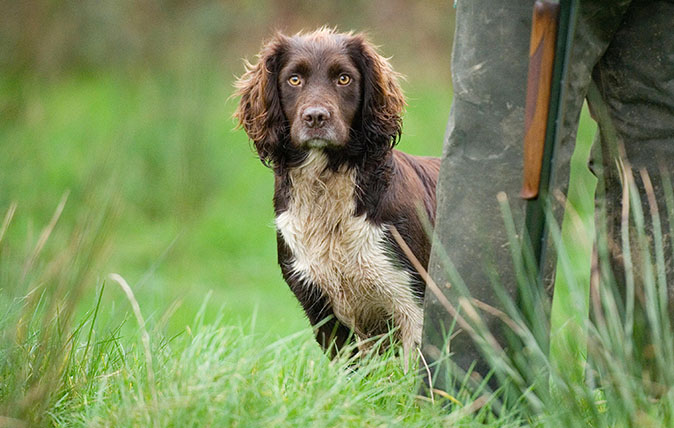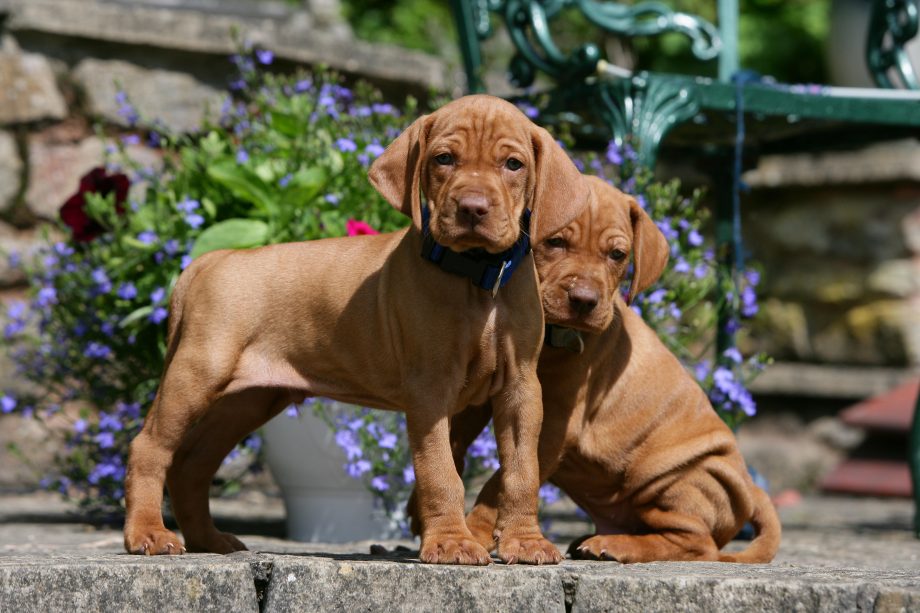Once the dog of Hungarian sporting nobility, the charismatic russet-gold vizsla, either wirehaired or smooth, has almost unmatched all-round ability in the field, discovers Katy Birchall.
‘Years ago, I was signing books at the Game Fair when someone came over with a wirehaired vizsla,’ recalls Giles Catchpole. ‘This striking dog, with its whiskery beard and a certain air of haughtiness, looked me right in the eyes as if to say, “Well, what do you reckon?”
‘Immediately, I knew this breed was the one for me. I started looking for a puppy and ended up with Rizla, who was with me for 15 years. He was the most charming dog I’ve ever come across.’

‘Rizla the vizsla’, as he was affectionately known, certainly left big paw prints to fill, but his young successor, Todd, is up to the challenge, already displaying the endearing qualities of the Hungarian wirehaired vizsla (HWV) that won over Mr Catchpole all those years ago. ‘They’re so docile, gentle and polite. When you first meet a vizsla, they look at you with a sort of superiority and then, once you tickle them under the chin, they just go to pieces. They’re terrific dogs to work, too,’ he adds. ‘They work like mad.’
When Mr Catchpole first acquired Rizla, the sight of an HWV working alongside labradors and spaniels in the shooting field was relatively uncommon, something he admits added to the breed’s appeal. ‘I fancied something a bit different, so I’d been looking at the hunt, point, retrieve (HPR) breeds,’ he recalls. ‘It’s amazing what you come across when you veer off the beaten track. Vizslas are so charismatic; they’re fantastic dogs, intelligent and with enormous character. They have a lot about them.’

The popularity of the HWV has steadily increased in recent years, as the sporting world eventually sat up and took notice of this russet-gold dog’s versatile abilities, handy weatherproof coat and loveable nature, which makes it an excellent family pet.
‘Almost every week, someone on a shoot will ask me about my dogs,’ admits gamekeeper Tracie Rickman, who’s worked HWVs for more than 20 years and currently has a team of 11. ‘They’re extraordinary all-round dogs and they love their work. Nothing beats watching them quarter the ground.’

After spotting an HWV on a shoot day in the early 1990s, it was love at first sight for Mrs Rickman. ‘At the time, I had a smooth vizsla and he was a wonderful dog, but I was struggling slightly with his drive and enthusiasm for picking up,’ she explains. ‘It was a chilly day, there was snow on the ground, and my dog sat there, shivering, whinging and whining away.
Jean Robertson, who I knew from the Norfolk and Suffolk HPR Field Trial Club, was also there with her wirehaired. Her dog sat beautifully by her side, not batting an eyelid in the cold, and went off on her command with no trouble, working steadily. I was struck by this dog’s incredible resilience and hardiness. I remember thinking “I must have one of those”. I fell in love with the breed on the spot and never looked back. It was a life-changing moment.’

The tough, resilient nature of the HWV is no accident—in the 1930s, Hungarian hunters crossed their smooth-haired vizslas with German wirehaired pointers in the hope of producing a multi-purpose dog with a heavy, rough coat suitable for working in cold, harsh conditions. Although, historically, the HWV is a fairly new gundog breed, the Hungarian vizsla is believed to have origins tracing back to the ninth century, when the Magyar tribes migrated from the steppes of Asia to the Carpathian mountain region, bringing their hunting dogs with them.
Once formally established by the end of the 16th century, the vizsla was the dog of Hungarian sporting nobility – a versatile hunter, it excelled at scenting birds that were then either netted or caught by falcons. It also went on to be greatly valued for its pointing and retrieving ability when working with the gun.
The First and Second World Wars took their tolls on vizsla numbers, and, as with many breeds, it was thanks to enthusiasts that it wasn’t wiped out altogether. Having been mostly confined to their homeland, vizslas were smuggled out of Hungary during the Soviet occupation and the breed began to be spotted across Europe in the late 1940s. The first imported Hungarian vizsla was recognised in Britain in 1953, but HWVs didn’t crop up here until the 1970s, and only began to make their mark two decades later.
‘The vizsla is also called the ‘Velcro’ dog, stuck to your side’
‘They’re great, robust dogs and brilliant for walked-up or rough shooting,’ enthuses Adrian Blackledge, owner of six HWVs. ‘It’s more relaxing than with, say, a spaniel, because the HWV will point – you’ve got time to walk up to the dog and get ready before telling it to flush. They’re beautiful to watch. One that’s trained properly, that is,’ he adds.
The winner of several accolades over the nine years he’s worked with HWVs, Mr Blackledge quashed any doubts over the breed’s abilities in 2016, when he became the first person to win both first and second place in the HPR Championship with Caesar and Amber, although he’s much too modest to go into detail – ‘yes, that was a pretty good day,’ he self-effacingly observes.
Mr Blackledge points out that the keen companionship of the HWV is a great advantage. ‘A lot of HPR breeds have a tendency to be a bit self-employed,’ he says jocularly. ‘When they’re hunting, you’re working them at such distances it can be easy for them to get carried away and off they go. The HWV is constantly in touch with the handler, no matter the distance. There’s a strong bond.’

This is a quality the HWV shares with the smooth-haired original, earning the vizsla a general nickname of the ‘Velcro’ dog, stuck to your side. However, as far as similarities between the smooth and wirehaired vizsla are concerned, there don’t seem to be many. ‘They’re completely different characters. Other than the colour and their need for human company, they don’t have much in common,’ notes Derek Whitfield, chairman of the Hungarian Vizsla Club and owner of five smooth-haired dogs. Speaking before a shoot day where his lot will be joined by an HWV, Mr Whitfield acknowledges that the HWV will likely be doing the picking up, when his vizslas will be in the beating line.
‘I always say there’s a reason why the “R” comes at the end of HPR. Mine aren’t always the best retrievers,’ he laughs.
With five dogs in the house, Mr Whitfield often struggles to find a space on the sofa – ‘we do have a kennel; it’s full of old furniture’– but, he sighs, there’s little point in trying to be cross at a vizsla. ‘They’re absolute clowns, with a real sense of humour. One of ours will curl her lips back and smile at you on command. They’ve got wonderful temperaments and are very intelligent, too. With their natural hunting drive, it’s important that they get a lot of stimulation. They’ll drive you mad if they don’t.’

Since Hungarian vizsla Yogi won Best in Show at Crufts in 2010, there has been an increase in puppy registrations and a subsequent rise in dogs ending up at one of the rescue charities devoted to the breed. ‘They’re not for everyone,’ Mr Whitfield stresses. ‘However, for those looking for a vizsla, who aren’t bothered about it being a puppy, a lot of the dogs coming into rescues don’t have any issues. Most were simply in the wrong home, not being used to their potential.’
Speak to any vizsla enthusiast, whether they’re in the smooth-coated or the wirehaired camp, and within seconds it becomes blindingly obvious that they are more than happy to have this Velcro dog stuck to their side for life. ‘I used to have a Russian military motorbike and sidecar – Rizla the vizsla would sit in the sidecar wearing his bandana and, together, we’d go ride around town,’ remembers Mr Catchpole with a wistful smile.

Which breed makes the best gundog? The pros and cons of labradors, spaniels, terriers and more
Whether you own labradors, springers, cockers or a mix of all three, debate over which gundog is best has raged

Fox-red labradors: Why red is the new black
From russet red to ever-so-slightly blushed, the fox-red is growing in popularity across the country sporting world. However, the gundog

The dog who ate a stuffed crocodile, and other incredible stories from last time we tried to find Britain’s naughtiest dog
Naughty dogs come in all shapes and sizes — as do their crimes and misdemeanours.





